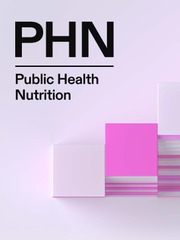Crossref Citations
This article has been cited by the following publications. This list is generated based on data provided by
Crossref.
Kengne, André Pascal
Amoah, Albert G.B.
and
Mbanya, Jean-Claude
2005.
Cardiovascular Complications of Diabetes Mellitus in Sub-Saharan Africa.
Circulation,
Vol. 112,
Issue. 23,
p.
3592.
2005.
Bibliography of papers from studies undertaken in Africa and published in Public Health Nutrition, 1998 to date.
Public Health Nutrition,
Vol. 8,
Issue. 5,
p.
448.
Asante, Augustine D
Zwi, Anthony B
and
Ho, Maria T
2006.
Getting by on credit: how district health managers in Ghana cope with the untimely release of funds.
BMC Health Services Research,
Vol. 6,
Issue. 1,
Nguyen, Minh Duc
Beresford, Shirley AA
and
Drewnowski, Adam
2007.
Trends in overweight by socio-economic status in Vietnam: 1992 to 2002.
Public Health Nutrition,
Vol. 10,
Issue. 2,
p.
115.
Schuster, Dara P.
Gaillard, Trudy
and
Osei, Kwame
2007.
The Cardiometabolic Syndrome in Persons of the African Diaspora: Challenges and Opportunities.
Journal of the CardioMetabolic Syndrome,
Vol. 2,
Issue. 4,
p.
260.
Mapatano, M.A.
Muyer, M.-C.
Buntinx, F.
De Clerck, M.
Okitolonda, W.
Bieleli, I.A.
and
Muls, E.
2007.
OBESITY IN DIABETIC PATIENTS IN KINSHASA, DEMOCRATIC REPUBLIC OF CONGO.
Acta Clinica Belgica,
Vol. 62,
Issue. 5,
p.
293.
Wiig, Kristen
and
Smith, Chery
2007.
An Exploratory Investigation of Dietary Intake and Weight in Human Immunodeficiency Virus–Seropositive Individuals in Accra, Ghana.
Journal of the American Dietetic Association,
Vol. 107,
Issue. 6,
p.
1008.
Malhotra, R
Hoyo, C
Østbye, T
Hughes, G
Schwartz, D
Tsolekile, L
Zulu, J
and
Puoane, T
2008.
Determinants of obesity in an urban township of South Africa.
South African Journal of Clinical Nutrition,
Vol. 21,
Issue. 4,
p.
315.
Abubakari, A. R.
Lauder, W.
Agyemang, C.
Jones, M.
Kirk, A.
and
Bhopal, R. S.
2008.
Prevalence and time trends in obesity among adult West African populations: a meta‐analysis.
Obesity Reviews,
Vol. 9,
Issue. 4,
p.
297.
Ouédraogo, Hermann Z
Fournet, Florence
Martin-Prével, Yves
Gary, Jean
Henry, Marie C
and
Salem, Gérard
2008.
Socio-spatial disparities of obesity among adults in the urban setting of Ouagadougou, Burkina Faso.
Public Health Nutrition,
Vol. 11,
Issue. 12,
p.
1280.
Sodjinou, Roger
Agueh, Victoire
Fayomi, Benjamin
and
Delisle, Hélène
2008.
Obesity and cardio-metabolic risk factors in urban adults of Benin: Relationship with socio-economic status, urbanisation, and lifestyle patterns.
BMC Public Health,
Vol. 8,
Issue. 1,
Abubakari, A.R.
and
Bhopal, R.S.
2008.
Systematic review on the prevalence of diabetes, overweight/obesity and physical inactivity in Ghanaians and Nigerians.
Public Health,
Vol. 122,
Issue. 2,
p.
173.
Uthman, Olalekan A.
2009.
Patterns, distribution, and determinants of under- and overnutrition among women in Nigeria: a population-based analysis.
Journal of Public Health,
Vol. 17,
Issue. 5,
p.
289.
Imoisili, Omoye E.
and
Sumner, Anne E.
2009.
Preventing diabetes and atherosclerosis in sub-Saharan Africa: Should the metabolic syndrome have a role?.
Current Cardiovascular Risk Reports,
Vol. 3,
Issue. 3,
p.
161.
Agyemang, Charles
Owusu-Dabo, Ellis
de Jonge, Ank
Martins, David
Ogedegbe, Gbenga
and
Stronks, Karien
2009.
Overweight and obesity among Ghanaian residents in The Netherlands: how do they weigh against their urban and rural counterparts in Ghana?.
Public Health Nutrition,
Vol. 12,
Issue. 7,
p.
909.
Ziraba, Abdhalah K
Fotso, Jean C
and
Ochako, Rhoune
2009.
Overweight and obesity in urban Africa: A problem of the rich or the poor?.
BMC Public Health,
Vol. 9,
Issue. 1,
Osei, Kwame
2010.
Metabolic Syndrome in Blacks: Are the Criteria Right?.
Current Diabetes Reports,
Vol. 10,
Issue. 3,
p.
199.
Mbanya, Jean Claude N
Motala, Ayesha A
Sobngwi, Eugene
Assah, Felix K
and
Enoru, Sostanie T
2010.
Diabetes in sub-Saharan Africa.
The Lancet,
Vol. 375,
Issue. 9733,
p.
2254.
Gaillard, Trudy
2010.
Insulin Resistance and Cardiovascular Disease Risk in Black People of the African Diaspora.
Current Cardiovascular Risk Reports,
Vol. 4,
Issue. 3,
p.
186.
de-Graft Aikins, Ama
Boynton, Petra
and
Atanga, Lem L
2010.
Developing effective chronic disease interventions in Africa: insights from Ghana and Cameroon.
Globalization and Health,
Vol. 6,
Issue. 1,


